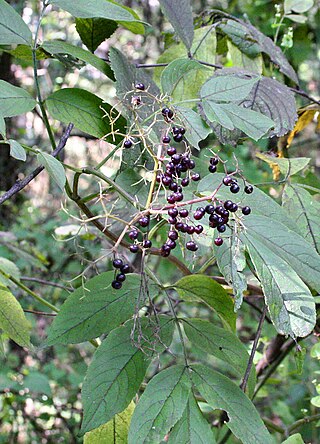
Sambucus canadensis, the American black elderberry, Canada elderberry, or common elderberry, is a species of elderberry native to a large area of North America east of the Rocky Mountains, south to Bolivia. It grows in a variety of conditions including both wet and dry soils, primarily in sunny locations.

Sambucus nigra is a species complex of flowering plants in the family Adoxaceae native to most of Europe. Common names include elder, elderberry, black elder, European elder, European elderberry, and European black elderberry. It grows in a variety of conditions including both wet and dry fertile soils, primarily in sunny locations. The plant is widely grown as an ornamental shrub or small tree. Both the flowers and the berries have a long tradition of culinary use, primarily for cordial and wine.

Sambucus gaudichaudiana, commonly known as white elderberry, is a species of flowering plant in the family Adoxaceae and is endemic to eastern Australia. It is a perennial shrub but with stems that are produced annually with pinnate leaves that have three to eleven leaflets, small white flowers and small but edible fruit. It grows in cool forest and shady gorges.

Zieria smithii, commonly known as sandfly zieria, lanoline bush or Smithian zieria, is a plant in the citrus family Rutaceae and is endemic to eastern and south-eastern Australia. It is a robust shrub with its leaves composed of three leaflets, and groups of flowers with four white petals, the groups usually shorter than the leaves. It is common and widespread along the coast and adjacent ranges.

Cuttsia viburnea is a shrub or bushy tree which has toothed leaves and panicles of white flowers, and that is endemic to eastern Australia. It is sometimes called silver-leaved cuttsia, and confusingly also native elderberry, honey bush or native hydrangea. C. viburnea is the only species assigned to the genus Cuttsia.

Pandorea pandorana, commonly known as the wonga wonga vine or wonga-vine, is a species of flowering plant in the family Bignoniaceae and is native to Australia, Malesia and the southwestern Pacific region. It is a woody scrambler or climber with pinnate leaves, juvenile leaves differing from those of mature plants. The flowers are tubular or funnel-shaped and white with purple markings and the fruit are capsules containing winged seeds. It is easy species to germinate and is a popular garden plant. Common cultivars include the yellow-flowered P. 'Golden Showers', the white-flowered P. 'Snowbells', and the pinkish P. 'Ruby Belle'. The wood was used in making spears for woomeras in the Central and Western deserts.

Zanthoxylum brachyacanthum, known as thorny yellow-wood, satinwood, satin tree or scrub mulga, is a species of flowering plant in the family Rutaceae and is endemic to north-eastern Australia. It is a rainforest shrub or tree with thick, cone-shaped spines on the trunk and prickles on the branches, pinnate leaves, and male and female flowers arranged in panicles.

Polyscias sambucifolia, commonly known as elderberry panax or small basswood, is a species of plant native to eastern Australia.

Flindersia xanthoxyla, commonly known as yellowwood, long jack or yellowwood ash, is a species of rainforest tree that is endemic to eastern Australia. It has pinnate leaves arranged in opposite pairs with seven to eleven leaflets, panicles of yellow flowers and woody fruit studded with rough points on the surface.

Vesselowskya rubifolia, commonly known as southern marara, red ash, mountain marara or Dorrigo southern marara, is a species of flowering plant in the family Cunoniaceae plant and has a restricted distribution in eastern New South Wales. It is a shrub or small tree with compound leaves with three or five leaflets with serrated edges, and small whitish flowers arranged along a raceme.

Androcalva fraseri, commonly known as blackfellow's hemp or brush kurrajong, is a species of flowering plant in the family Malvaceae and is endemic to eastern Australia. It is a small tree or shrub that forms suckers and has egg-shaped or lance-shaped leaves with serrated edges, and clusters of 13 to 21 white flowers.
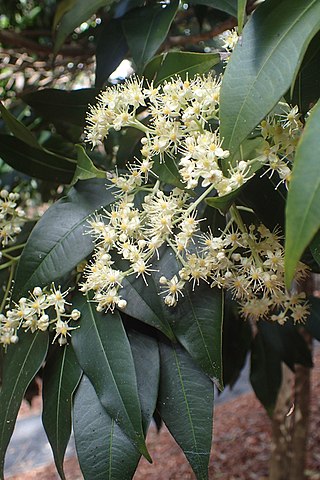
Bosistoa floydii, commonly known as the five-leaf bosistoa or five-leaved bonewood, is a species of small rainforest tree that is endemic to north-eastern New South Wales. It has pinnate leaves usually with five elliptic leaflets, and panicles of tiny, creamy white flowers.

Bosistoa transversa, commonly known as yellow satinheart, or three-leaved bosistoa, is a species of small to medium-sized rainforest tree that is endemic to eastern Australia. It has mostly pinnate leaves, usually with three leaflets, and panicles of small white flowers.

Lepiderema pulchella, commonly known as fine-leaved tuckeroo, is a species of flowering plant in the family Sapindaceae and is endemic to coastal eastern Australia. It is a tree with pinnate, glossy light green leaves with four to fourteen leaflets, panicles of yellow-orange flowers and brown, spherical to three-lobed fruit.

Senna septemtrionalis, commonly known as arsenic bush, is a species of flowering plant in the family Fabaceae and is native to Central America, the southern United States and Mexico, but is naturalised in many other countries. It is an erect shrub with pinnate leaves, with four or five pairs of egg-shaped leaflets, and yellow flowers arranged in groups of five to eight, usually with seven fertile stamens and four staminodes in each flower.

Leptospermum obovatum, commonly known as river teatree, is a species of shrub that is endemic to south-eastern continental Australia. It has egg-shaped or lance-shaped leaves that are narrower at the base, white flowers usually arranged singly on short side shoots and fruit that remains on the plant until it dies.
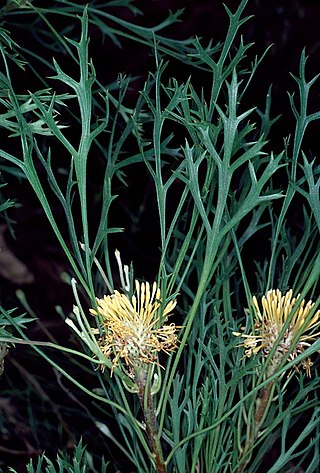
Isopogon petiolaris is a species of plant in the family Proteaceae and is endemic to eastern Australia. It is a low, spreading shrub with sharply-pointed, divided leaves and more or less spherical heads of yellow flowers.

Elaeocarpus culminicola, commonly known as Michael's quandong, is a species of flowering plant in the family Elaeocarpaceae and is native to parts of Malesia and Australasia. It is a tree with wavy leaves with wavy or toothed edges, racemes of white, cream-coloured or pink flowers and more or less spherical fruit.
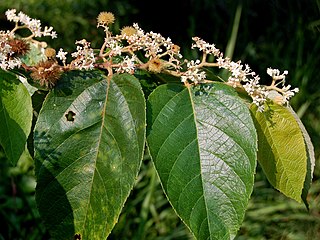
Commersonia bartramia, commonly known as brown kurrajong, is a species of flowering plant in the family Malvaceae and is native to Southeast Asia, the Northern Territory, Queensland and New South Wales. It is a tree or shrub with heart-shaped to egg-shaped leaves much paler on the lower surface, and sometimes with fine, irregular teeth on the edges.
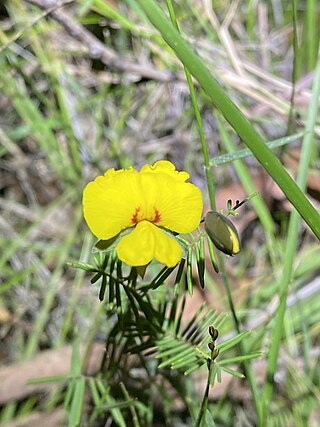
Gompholobium pinnatum, commonly known as pinnate wedge-pea, is a species of flowering plant in the pea family Fabaceae and is endemic to eastern Australia. It is an ascending or erect shrub with pinnate leaves and yellow flowers with red marks.




















